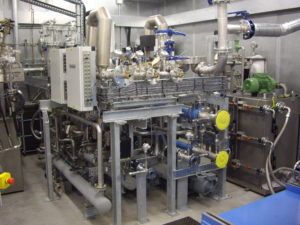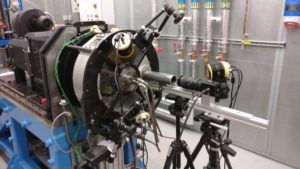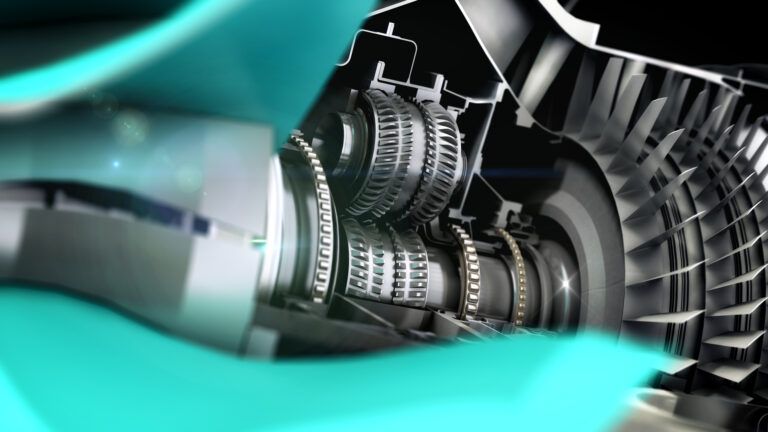Words by Ben Sampson
Rolls-Royce’s Gas Turbines and Transmissions Centre at Nottingham University is using innovative testing to turn research into industrial applications.
Improvements in the performance of jet engines are not easily obtained. They are already highly optimized to make the best use of high-performance materials, designs and manufacturing techniques. Manufacturers spend millions of pounds on research and testing to achieve improvements in technology and efficiency for future aircraft engines.
Rolls-Royce conducts much of its R&D within academia, via its network of University Technology Centres (UTCs). The University Technology Centre in Gas Turbine Transmission Systems is a UTC within the Gas Turbine and Transmissions Research Centre (G2TRC) at the University of Nottingham in the UK.
The G2TRC aims to improve the understanding of jet engine turbine cores and transmission architectures so that engineers can develop new technologies and analysis methods to improve engine efficiency and reduce environmental impact.
A computational approach

Around two thirds of G2TRC research and design work relates to fluid systems in the transmissions of gas turbines. The other third is in the area of solid mechanics, looking at new materials, structures, rotor-dynamics and tribology research.
Around half of the G2TRC’s research is computational and the other half is experimental testing. Much of the computational work involves advanced and novel applications of Computational Fluid Dynamics (CFD) and Finite Element Analysis (FEA), amongst other approaches. A recent example is the use of Smooth Particle Hydrodynamics (SPH) to simulate fluids as particles instead of using the normal CFD techniques.
G2TRC’s computational research is located in a large open plan office on the top floor of the G2TRC’s modern building at the University of Nottingham’s Jubilee Campus. The group uses its own 800 core high performance computing (HPC) resource. This is located in a secure data centre owned and managed by the University at a nearby campus. Another University HPC (2000 core) and centralised national
HPC facilities are also used by researchers when required. Researchers and PhD students access the HPCs work remotely via high-performance computer workstations arranged around the office in clusters for each main research program and major discipline. On a typical day pre the Covid-19 pandemic, researchers and students could be seen creating and adjusting models and code on screens around the office.
The Research Centre is the focal point of the G2TRC and where most of the group’s 50 members are situated. They cover a wide range of projects, from developing simulations for weld characterization to CFD for oil system design and development. The post-doctoral researchers work collaboratively with PhD research students, undergraduate project students and several ex Rolls-Royce technical specialists.
There is also an engineering and technical team at hand to provide support. “They work full time on design and rig / facility development and support– using a range of CAE [computer aided engineering] packages to develop the mechanical, electrical and controls elements of the large-scale test rigs used in the group’s experimental work. There is software development too, specifically for rig control and instrumentation. This highly skilled engineering and technical group is an asset not many UTCs have,” says Tim Whitehouse, project manager at the Rolls-Royce Gas Turbine Transmission Systems UTC.
Test cells

Experiments to verify the computational work and test new designs are conducted by researchers and technicians in a large laboratory space below the main computational hub. The head of the G2TRC, Professor Carol Eastwick says that the aim is to work in a highly structured, methodical and well project-managed way.
The center has six-test cells. The most recent addition to its research and testing capability is the Three Shaft Facility, which was funded by the UK’s Aerospace Technology Institute (ATI) and launched in April 2019. The cell has twin-290kW drives that can operate at up to 35,000rpm with a separate third 60,000rpm drive that can act as either a load which simulates a jet engine configured with a radial drive shaft power off-take, or as a drive in its own right for high-speed testing. The multi-million facility was supplied and installed by a UK-based company and is being used to conduct engine research for Rolls-Royce and other customers.
The drives can be orientated in a number of different configurations allowing for a maximum test envelope of 1.5m3. This enables the testing of large items. Modules can be pressurized and fed air to recreate the in-flight environment. Four subsidiary systems are available in the facility: one to deliver up to three controlled oil feeds to test modules at up to 60 litres/minute, another to supply three controlled airflows of up to 160g per second. There is an oil system that extracts oil through three lines at up to 175 litres/minute and an air system that is able to remove air through 2 channels at up to 200g per second.
The Three Shaft Facility can also be configured in different ways to recreate different transmission arrangements, for example for tail rotor gearboxes for helicopters. All of the drives have the capability to recirculate power from one shaft to another. This is useful when testing large gearboxes, so that only net losses need to be supplied – with one drive acting as a motor and the other(s) as a load. For applications operating at above atmospheric pressure, testing often takes place under a nitrogen atmosphere to avoid risk of oil fires through hot oil vapor combustion in air. One of the other facilities in the G2TRC has a nitrogen re-circulation system so that gas usage is reduced to a minimum.
“This is a flexible, national facility that can be used by a variety of industrial and academic partners,” said Professor Seamus Garvey, director of the Gas Turbine Transmission Systems UTC “The value of our work is that we can look at the components of gas turbines in great detail, complementing research that involves running an entire engine.”
Bearing oil

Setup in an adjacent test cell, there is a bespoke test rig that is being used to see how oil moves into bearing chambers from the bearings within the core of a jet engine. The rig was originally jointly funded by a substantial grant from the UK Government backed Innovate UK organization under the Siloet 2 program. This was augmented by industrial funding from Rolls-Royce and later in follow-up projects with more funding from the UK Government and the EU. It is a typical transmission UTC project, involving a coalition of partners, with members from other academic institutions and industries.
The test rig has a large aero engine shaft location bearing mounted in a bulkhead. The rig is capable of applying an axial thrust load equivalent to that experienced by a bearing at Maximum Take Off. The bearing is driven by a motor through a torque transducer. A high-speed camera looks through a port to capture images of the oil as it enters the bearing chamber. The rig also measures the oil’s temperature, pressure and flow rate.
The imaging system captures images of between 4 to 40cm2 in an area showing individual oil droplets and films of oil entering the chamber which are then analyzed. Testing involves reaching stable operation at various speeds and loads representing the various points in a typical flight cycle such as ground idle, take off, climb and cruise. The rig applies the actual load the bearing would experience in flight.
Like most of the research conducted at the G2TRC, Siloet 2 contributes to efforts to improve fuel consumption and reduce losses that lead to improved efficiency. Oil flow and heat management are important because if oil resides in the chambers for too long, it might not be doing its cooling job as well as it should. The research will help Rolls-Royce engineers develop design guidelines for use in future engine projects.





